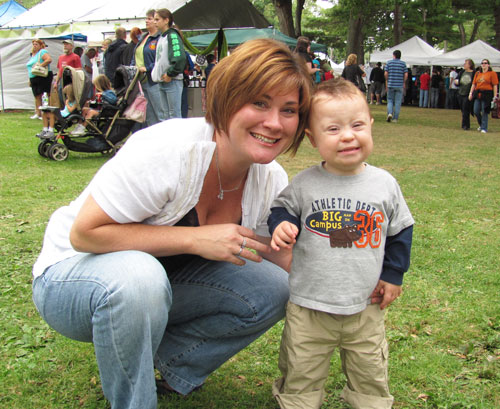
Questions and Answer’s
What Causes Down Syndrome?
 In every cell in the human body there is a nucleus, where genetic material is stored in genes. Genes carry the codes responsible for all of our inherited traits and are grouped along rod-like structures called chromosomes. Normally, the nucleus of each cell contains 23 pairs of chromosomes, half of which are inherited from each parent.
In every cell in the human body there is a nucleus, where genetic material is stored in genes. Genes carry the codes responsible for all of our inherited traits and are grouped along rod-like structures called chromosomes. Normally, the nucleus of each cell contains 23 pairs of chromosomes, half of which are inherited from each parent.
Down syndrome is usually caused by an error in cell division called "nondisjunction." Nondisjunction results in an embryo with three copies of chromosome 21 instead of the usual two. Prior to or at conception, a pair of 21st chromosomes in either the sperm or the egg fails to separate. As the embryo develops, the extra chromosome is replicated in every cell of the body. This type of Down syndrome, which accounts for 95% of cases, is called Trisomy 21.
The two other types of Down syndrome are called mosaicism and translocation. Mosaicism occurs when nondisjunction of chromosome 21 takes place in one-but not all-of the initial cell divisions after fertilization. When this occurs, there is a mixture of two types of cells, some containing the usual 46 chromosomes and others containing 47. Those cells with 47 chromosomes contain an extra chromosome 21. Mosaicism accounts for about 1% of all cases of Down syndrome. Research has indicated that individuals with mosaic Down syndrome may have fewer characteristics of Down syndrome than those with other types of Down syndrome. However, broad generalizations are not possible due to the wide range of abilities people with Down syndrome possess.
Translocation accounts for about 4% of all cases of Down syndrome. In translocation, part of chromosome 21 breaks off during cell division and attaches to another chromosome, typically chromosome 14. While the total number of chromosomes in the cells remain 46, the presence of an extra part of chromosome 21 causes the characteristics of Down syndrome.
Regardless of the type of Down syndrome a person may have, all people with Down syndrome have an extra, critical portion of chromosome 21 present in all or some of their cells. This additional genetic material alters the course of development and causes the characteristics associated with Down syndrome.
The cause of nondisjunction is currently unknown, but research has shown that it increases in frequency as a woman ages. However, due to higher birth rates in younger women, 80% of children with Down syndrome are born to women under 35 years of age. There is no definitive scientific research that indicates that Down syndrome is caused by environmental factors or the parents' activities before or during pregnancy.
Once a woman has given birth to a baby with Trisomy 21, it is estimated that her chances of having another baby with Trisomy 21 is 1% greater than her chances by age alone.
The age of the mother does not seem to be linked to the risk of translocation. Most cases are sporadic-that is, chance events. However, in about one third of cases, one parent is a carrier of a translocated chromosome. The risk of recurrence of translocation is about 3% if the father is the carrier and 10-15% if the mother is the carrier. Genetic counseling can determine the origin of translocation.
How is Down syndrome Diagnosed?
Prenatally
There are two types of tests for Down syndrome that can be performed before a baby is born: screening tests and diagnostic tests. Prenatal screens estimate the chance of the fetus having Down syndrome. These tests only provide a probability. Diagnostic tests can provide a definitive diagnosis with almost 100% accuracy.
Most screening tests involve a blood test and an ultrasound (sonogram). The blood tests (or serum screening tests) measure quantities of various substances in the blood of the mother. Together with a woman's age, these are used to estimate her chance of having a child with Down syndrome. These blood tests are often performed in conjunction with a detailed sonogram to check for "markers" (characteristics that some researchers feel may have a significant association with Down syndrome). Recently, researchers have developed a maternal serum/ultrasound/age combination that can yield a much higher accuracy rate at an earlier stage in the pregnancy. Still, the screen will not definitively diagnose Down syndrome.
Prenatal screening tests are now routinely offered to women of all ages. If the chance of having a child with Down syndrome is high from prenatal screening, doctors will often advise a mother to undergo diagnostic testing if they desire a definitive diagnosis.
The diagnostic procedures available for prenatal diagnosis of Down syndrome are chorionic villus sampling (CVS) and amniocentesis. These procedures, which carry up to a 1% risk of causing a spontaneous termination (miscarriage), are practically 100% accurate in diagnosing Down syndrome. Amniocentesis is usually performed in the second trimester after 15 weeks of gestation, CVS in the first trimester between 9 and 11 weeks.
 At Birth
At Birth
Down syndrome is usually identified at birth by the presence of certain physical traits: low muscle tone, a single deep crease across the palm of the hand, a slightly flattened facial profile and an upward slant to the eyes. Because these features may be present in babies without Down syndrome, a chromosomal analysis called a karyotype is done to confirm the diagnosis. To obtain a karyotype, doctors draw a blood sample to examine the baby's cells. They use special tools to photograph the chromosomes and then group them by size, number, and shape. By examining the karyotype, doctors can diagnose Down syndrome. Another genetic test called FISH can apply similar principles and confirm a diagnosis in a shorter amount of time.
What is Down syndrome?
Down syndrome is the most common genetic condition. One in every 691 babies is born with Down syndrome. The most common form of Down syndrome is called Trisomy 21, because it involves an extra copy of the 21st chromosome.
What impact does Down syndrome have on society?
Individuals with Down syndrome are becoming increasingly integrated into society and community organizations, such as school, health care systems, work forces, and social and recreational activities. Individuals with Down syndrome possess varying degrees of intellectual disabilities, from very mild to severe. Most people with Down syndrome have IQs in the mild to moderate range of intellectual disability.
Due to advances in medical technology, individuals with Down syndrome are living longer than ever before. In 1910, children with Down syndrome were expected to survive to age nine. With the discovery of antibiotics, the average survival age increased to 19 or 20. Now, with recent advancements in clinical treatment, most particularly corrective heart surgeries, as many as 80%of adults with Down syndrome reach age 60, and many live even longer.
In the United States, approximately 400,000 families have a child with Down syndrome, and about 6,000 babies with Down syndrome are born each year. More and more Americans will interact with individuals with this genetic condition, increasing the need for widespread public education and acceptance.
Who has the highest risk of having a child with Down syndrome?
Down syndrome can occur in people of all races and economic levels. Older women have an increased chance of having a child with Down syndrome. A 35-year-old woman has about a one in 350 chance of conceiving a child with Down syndrome, and this chance increases gradually to one in 100 by age 40. At age 45 the incidence becomes approximately one in 30.
 Since many couples are postponing parenting until later in life, the incidence of Down syndrome conceptions is expected to increase. Therefore, genetic counseling for parents is becoming increasingly important. Still, many physicians are not fully informed about advising their patients about the incidences of Down syndrome, advancements in diagnosis, and the protocols for care and treatment of babies born with Down syndrome.
Since many couples are postponing parenting until later in life, the incidence of Down syndrome conceptions is expected to increase. Therefore, genetic counseling for parents is becoming increasingly important. Still, many physicians are not fully informed about advising their patients about the incidences of Down syndrome, advancements in diagnosis, and the protocols for care and treatment of babies born with Down syndrome.
In addition, individuals with Down syndrome have a higher incidence of certain medical conditions, and the study of Down syndrome may yield important breakthroughs in those areas. Research in Down syndrome provides a way for looking at many important problems:
- Heart disease: Up to 50% of individuals with Down syndrome are born with congenital heart conditions. The majority of heart conditions in children with Down syndrome can now be surgically corrected with resulting long-term health improvements. However, scientists continue to search for the cause of these heart conditions and look for means of prevention.
- Alzheimer's disease: Estimates vary, but it is reasonable to conclude that 25% or more of individuals with Down syndrome over the age of 35 will develop the clinical signs and symptoms of Alzheimer's-type dementia.
- Leukemia: Approximately one in every 100 individuals with Down syndrome will develop leukemia; or, to put it another way, 99% of people with Down syndrome will not develop leukemia. The majority of cases are categorized as acute megakaryoblastic leukemia, which tends to occur in the first three years of life, and for which there is a high cure rate. A transient form of leukemia is also seen in newborns with Down syndrome, disappearing spontaneously during the first two to three months of life.
Source: National Down Syndrome Congress
National Down Syndrome Society
Events
NEWS
NOT UP FOR THE FULL 63 MILES?
Not sure if you're up for the full ride? We have decide to try something new.




